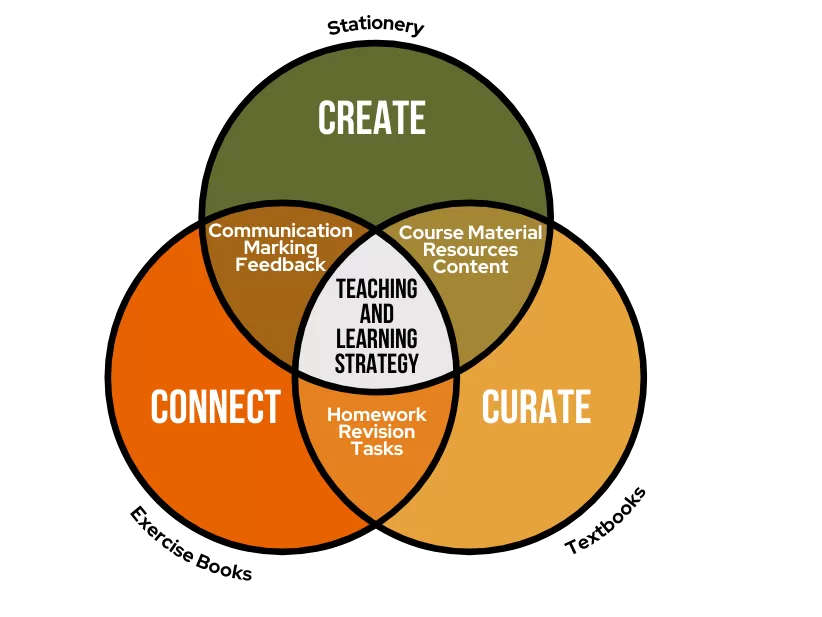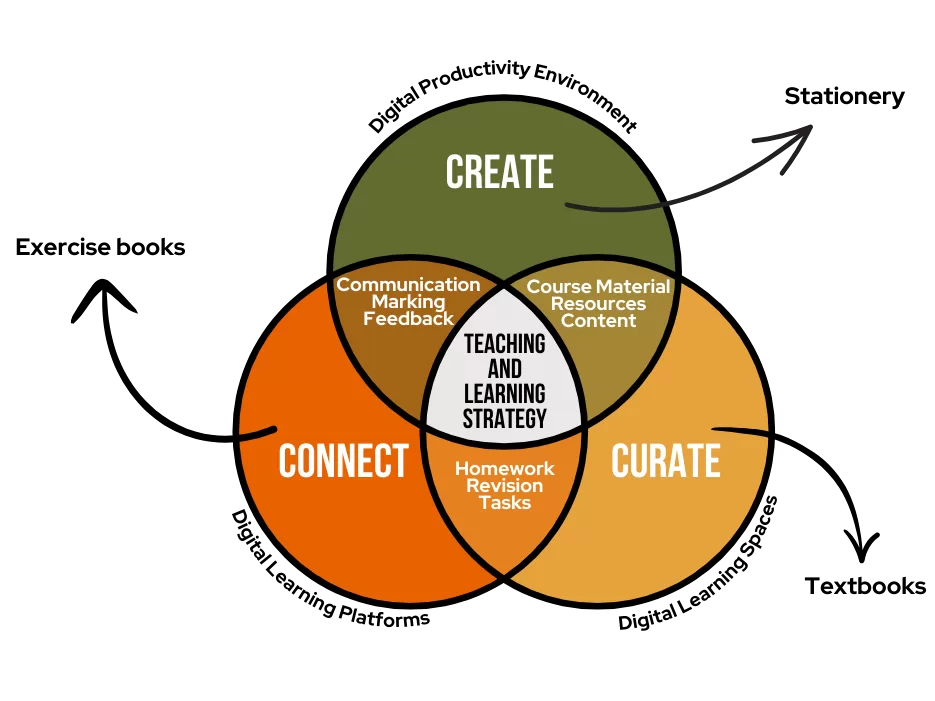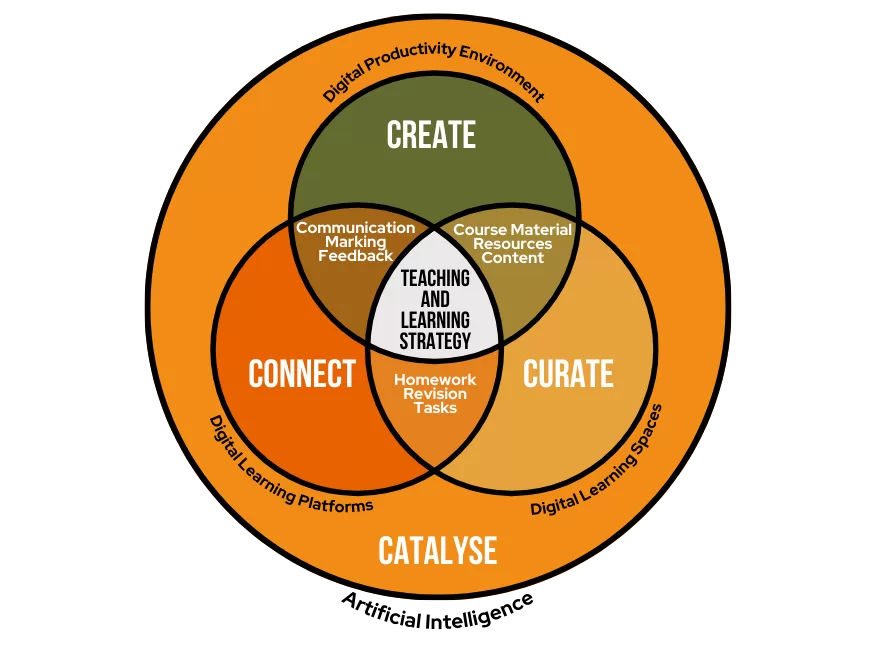Walk into any classroom and you’ll find three things in play: content, activity, and communication. Teachers teach; students learn (we hope); materials are shared, discussed, and acted upon. Whether the medium is pen and paper or tablet and app, the essential task remains the same: to help students acquire knowledge, make sense of it, and use it meaningfully.
The main strategies have not changed significantly, and for good reason, at least in my 20 years plus of teaching experience. What has changed is how our strategic thinking has evolved to accommodate new tools and new expectations.
Originally devised as a thought experiment to help me better understand the impact of AI’s irruption into this space, this article explores that evolution, using a series of diagrams as a heuristic to help trace how schools are adapting their teaching and learning strategies to a digital and now AI-infused world.
1. Paper, Pen, and Pedagogy: Anchoring Learning in What Works

This first diagram represents the traditional teaching toolkit, and it still works remarkably well. In many classrooms, you’ll find:
- Textbooks (Curate) – the curated source of knowledge
- Exercise books (Connect) – where work is done, feedback is received, and progress is tracked
- A pencil case or stationery set (Create) – the tools for constructing, organising, expressing understanding
These tools are deceptively simple. But their power lies in how well they align with what we know about how students learn:
- Curate – Content needs to be selected and sequenced with care to reduce extraneous cognitive load and to activate prior knowledge.
- Connect – Regular feedback and rehearsal strengthen retrieval pathways and promote metacognitive regulation.
- Create – Learning is enhanced when students generate their own outputs through elaboration and the process of making meaning for themselves
In other words, this low-tech model is profoundly high-theory. It works because it respects the cognitive architecture of the human mind.
Some argue that digital tools are a distraction, that real learning demands paper, pens, and direct human proximity. That concern is valid. Digital tools can distract if poorly chosen or clumsily implemented. But the same was once said of the printing press, the calculator, and the overhead projector. The key is not to use technology for its own sake, but to anchor it in what we know works: clarity, feedback, retrieval, self-regulation.
2. The Three Cs: Toward a Coherent Digital Strategy

As digital tools have become ubiquitous in schools, the challenge has never been mere adoption, but rather integration with intention. This second diagram reflects this evolution: teaching and learning remain at the centre.
In this model teachers don’t “Which app?” but rather“What learning will this enable?” And the answers, increasingly, are shaped by tools that echo the traditional functions of effective teaching:
- Curate now includes SharePoint sites, online textbooks, and school portals, structured knowledge environments that reduce cognitive overload and support retrieval.
- Create incorporates tools like Google Docs, Canva, OneNote, and iPad apps, allowing students to express, model, and represent their thinking.
- Connect lives in platforms like Microsoft Teams, Google Classroom, and Showbie, providing channels for feedback, communication, and shared reflection.
But digital teaching and learning strategies continue to evolve and remain alive to the changing needs of learners, the growing expertise of teachers, the shifting demands of curricula, and the emergence of new technologies. A static strategy is no strategy at all.
This leads us to deeper questions:
- Are our tools amplifying learning, or merely increasing complexity?
- Do they help students plan, monitor, and evaluate their own thinking?
- Do they lighten the load for teachers, or just add to it?
- Are we building systems of coherence, where students encounter consistent expectations, routines, and supports?
Digital tools can empower, but only if they are rooted in the same cognitive principles that underpin good teaching.
There are those who argue that what we need is not integration but transformation, that the very foundations of education should be upended and rebuilt. This is a compelling proposition, particularly for those who see in the current education system a structure creaking at the seams and ripe for radical reimagining.
AI may well force us to rethink many long-held assumptions. But we must be cautious about mistaking transformation for rupture. The principles that underpin effective learning (memory, motivation, metacognition) are not made obsolete by new tools. They are made more urgent and significant.
This approach offers a way to build coherence as we adapt. If transformation is the solution, I suspect it will arrive through understanding and deliberate iteration, not through disruption.
3. The 4th C? AI as Operating System

And now, we arrive at the present moment. AI, most notably large language models (LLMs) like ChatGPT, has entered schools not through deliberate adoption, but, as is often the case, through the side door of student initiative. For many of us, it is no longer a question of whether to engage with AI, but how.
The outer ring in this final diagram introduces Catalyse, a potential fourth C. But here we pause and pose a question:
Is AI a true fourth domain, encompassing and enhancing the other three – Curate, Create, Connect – or is it simply an extension of Create, the domain where students work with and on ideas?
The jury is still out. What’s clear is that AI, when used well, can:
- Help Curate relevant content or simplify complex texts
- Prompt and scaffold Creation by suggesting structures, models, or feedback
- Connect learners to feedback loops through automated questioning or revision tools
But it can also short-circuit thinking if used poorly, offering surface answers and the illusion of learning instead of deep understanding.
As Sam Altman, CEO of OpenAI (the makers of ChatGPT), recently observed:
“We’re seeing younger people use ChatGPT almost like an operating system for their lives.”
That should both impress and alarm us. If AI becomes the logic through which students access, process, and respond to knowledge, then we must ask: What habits of mind are we encouraging? What kind of learners are we producing?
The more things change…
The evolution traced here is not from old to new, but rather from isolated practices to integrated thinking. From pencil cases to platforms. From lesson planning to ecosystem design. From tool choice to cognitive alignment.
Teaching and learning remain the constant. But how we support them must evolve.
Curate wisely.
Create purposefully.
Connect with care.
Catalyse with intention, clarity, curiosity, and, for now, caution.
Because in the end, technology may transform the context, but learning still happens in the mind. The best strategies today are not about keeping up with technology, but about keeping faith with learning. They begin with what we know about memory, motivation, feedback, and thinking, and they use digital tools, including AI, to support those processes rather than disrupt them.
“Greatness is not a function of circumstance. Greatness is largely a matter of conscious choice.”
— Jim Collins
Subscribe to my newsletter
- Actionable insights on leadership, learning, and organisational improvement
- Thought-provoking reflections drawn from real-world experience in schools and beyond
- Curated resources on effective practice and digital strategy
- Early access to new articles, events, and consultancy updates
- Invitations to subscriber-only webinars, Q&As, and informal conversations
- Clarity, not clutter—you will not be bombarded by emails
Cancel or pause anytime.
Leave a Reply